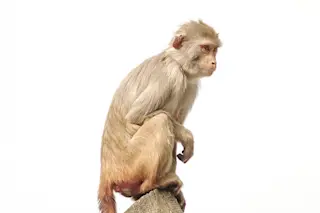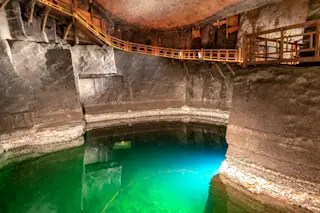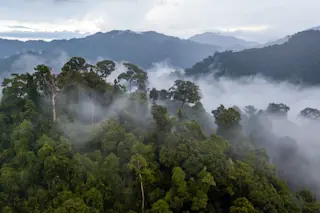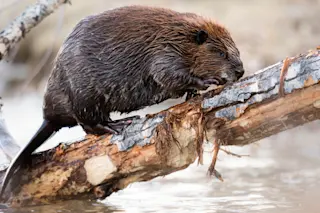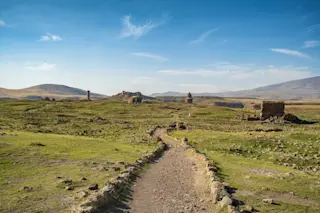Worldwide, people drink over 65 billion gallons of alcohol each year. The United States’ share, if divided equally across the adult population, would amount to about two and a half gallons of pure alcohol per person, annually. And this thirst seems to be universal: Fermented beverages have been found in nearly every society, as far back as archaeologists can detect their existence.
That’s the idea behind the “drunken monkey” hypothesis, formulated by biologist Robert Dudley in 2000.
According to the hypothesis, our pre-human ancestors regularly ingested small amounts of alcohol because the substance is produced when ripe fruit or nectar is decomposed by wild yeast. Through natural fermentation, yeast feeds on plant sugars and produces waste products of CO2 and ethanol — the chemical name for alcohol.
Although this spoils fruit, it presents an opportunity for animals that can digest alcohol. Creatures able to eat fermenting sugars would have an additional source of nutrients. Not only would they consume semi-rotten fruits, passed over by other animals, but alcohol itself has nutritional value: There are nearly twice as many calories in ethanol compared to carbohydrates of the same weight. (While this causes unwanted beer bellies today, extra calories are beneficial in the wild.)
Also, fermentation produces strong odors. An animal attracted to the yeasty scent would be able to follow its nose to edible fruit, and potentially find that food source before creatures without the taste for alcohol. And lastly, as many of us have experienced, alcohol stimulates appetite. Individuals munching on fermented fruit may eat more, obtaining bonus calories and nutrients.
In these ways, developing a taste for alcohol — the low levels found in nature — could have given our ancestors an advantage. In a forest full of animals competing for energy-rich foods, “drunk monkeys” would have access to an untapped resource.
It wasn’t until millions of years later, after Homo sapiens created beverages with unnaturally high ethanol concentrations (i.e. beer, wine, liquor), that alcohol consumption became a social and public health issue. According to Dudley, alcohol abuse and addiction are an “evolutionary hangover” of a deep-routed taste for fermented sugars, adaptive long ago.
Boozy Primates
This hypothesis concerns a period of our evolution before the human lineage diverged from other primates. During the Miocene, roughly 5 to 23 million years ago, Earth was a real planet of the apes. Fossils of up to 100 different species have been found across Africa, Europe and Asia.
The African great apes — humans, chimpanzees and gorillas — were still part of the same lineage; they had not yet branched onto separate evolutionary paths. This ancestral creature likely lived in a tropical forest, and fed mostly on fruit, based on the look of teeth from fossil apes of the era.
While it’s well established that our Miocene ancestors probably dined on fruit, there’s no direct evidence they chose fermenting ones. However, there are hints this is true from other living primates.
There have been many anecdotal reports of primates boozing. For example, on the Caribbean island of St. Kitts a population of introduced green monkeys routinely steal unattended cocktails. Experiments on a captive sub-group showed that 17 percent preferred rum-spiked sugar water to “virgin” sugar water. This suggests that taste for alcohol depends on the individual. Such natural variation in alcohol habits is necessary for it to be subject to evolution by natural selection.
But invasive monkeys attacking tourist daiquiris is hardly a natural setting. Do primates imbibe in the wild?
A 2008 study, using radio collars and hidden cameras showed that slow lorises and other mammals of West Malaysia regularly lick up fermented nectar from the flower buds of bertam palms. The fermented nectar had an average alcohol content of 0.6 percent, but the maximum measured amount was 3.8 percent, comparable to light beer. The slow lorises — literally lightweights at just 1.5 pounds — did not show any physical signs of inebriation, despite the fact that they spent more time at the palm buds than any other food source.
And a 2015 paper was the first scientific report of voluntary alcohol consumption by chimpanzees, our closest living relatives. In the town of Bossou, Guinea in West Africa, villagers installed plastic containers on raffia palms to collect fermented sap, with alcohol content averaging 3.1 percent and reaching nearly 7 percent. A group of crafty chimps learned to shape leaves into sponge-like tools in order to extract the sugary brew. In observations between 1995 and 2012, the team documented 13 different chimps go for a drink a total of 51 times. This finding supports the idea that the common ancestor of chimps and humans “was not averse to ingesting foods containing ethanol,” wrote the study authors.
Genes for Guzzling
Another way to test the drunken monkey hypotheses is to search for genetic adaptations that enhance alcohol digestion, and to determine when during our evolution those mutations arose.
Keep in mind though, there are numerous genes involved in the metabolic breakdown of alcohol. The DNA of distinct lineages may have been tweaked in different ways to independently evolve a taste for ethanol. In other words, the green monkeys and slow loris may (or may not) have unique adaptations that enable their drinking habits.
But at least one genetic change has been identified to explain the ancient origins of our love for booze. In a 2015 Proceedings of the National Academy of Sciences paper, scientists focused on ADH4 genes, which code for the first enzyme to encounter and metabolize alcohol during digestion. The particular genetic code for this protein differs across species. Comparing sequences from 18 primates, the scientists discovered a single-letter DNA change in this enzyme that increases ethanol metabolism 40-fold. That mutation was found in chimpanzees, gorillas and humans, suggesting it was also probably present in the last common ancestor of all three species.
This ancestral ape likely roamed tropical forests of Africa over 10 million years ago, and enjoyed an occasional nightcap.


